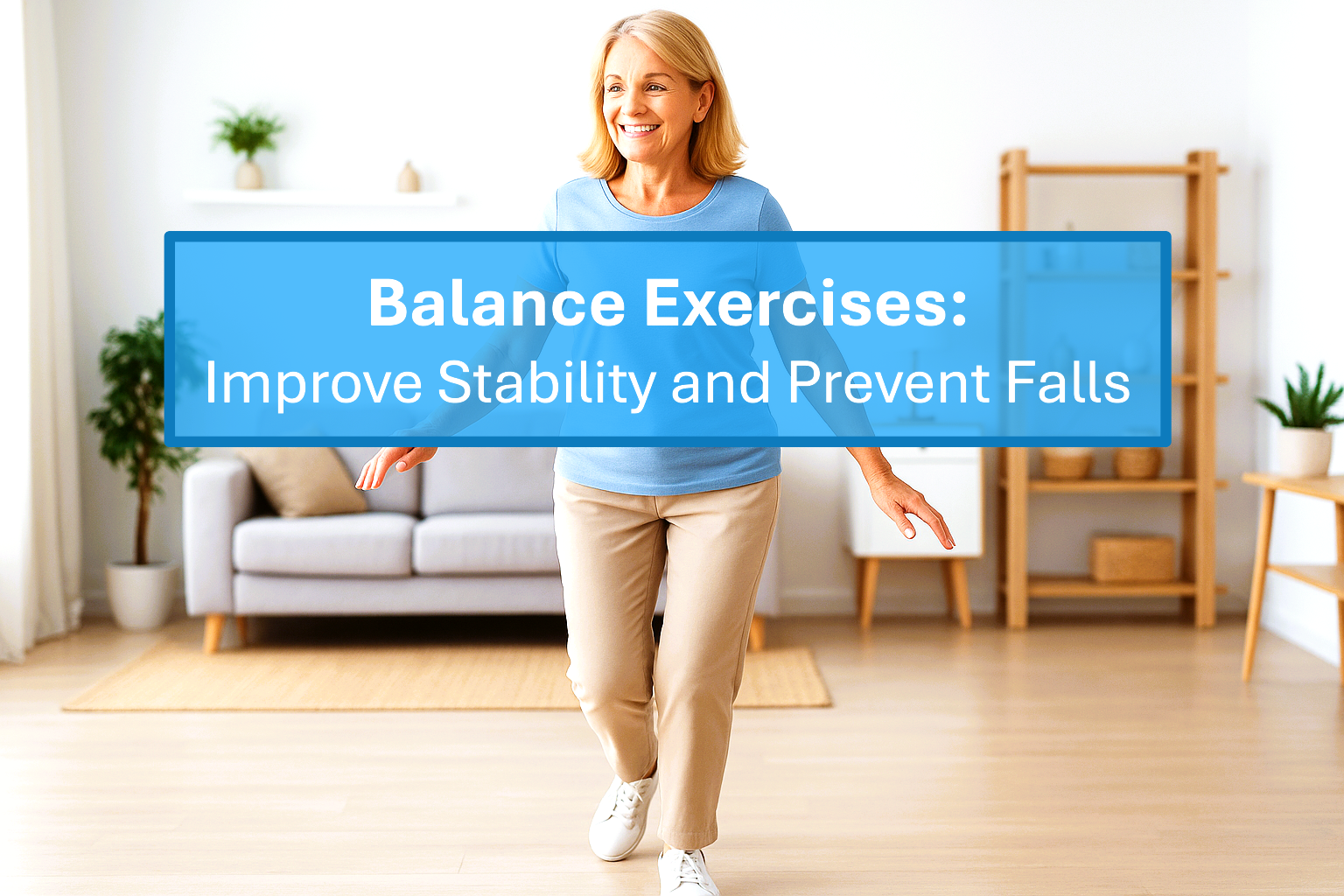Persistent Pain: When to See a Physiotherapist...
Key Highlights: Persistent pain is discomfort that lasts for more…
Read More
Posted by Dr. Scott Wilson | 01-Nov-2025
Balance exercises are one of the most effective ways to stay steady, confident, and mobile as you age. Over time, changes in muscle strength, joint flexibility, and coordination can make you feel less secure on your feet. It can also increase your risk of slips or falls and limit your ability to stay active. The good news is that you can rebuild balance and confidence at any age. In this article, we’ll show you how simple, safe balance exercises can improve stability, strength, and overall quality of life. Here’s what you need to know.
Before learning new balance exercises, it helps to understand why balance matters so much in everyday life. Good balance is a complex skill that relies on your muscles, joints, eyes, and inner ear working together. This physical coordination allows you to move confidently, react to sudden changes, and perform daily tasks without fear of falling. Fear of falling is a growing concern for aging adults.
Strong balance depends on your core, lower back, and leg muscles working in harmony to keep you centered. When balance declines, simple movements like reaching or turning can feel more difficult. Balance exercises strengthen the muscles that keep you steady and improve your reaction time, helping you avoid injuries. They also help to support your long-term mobility, independence, and overall health. Staying active not only enhances physical stability but also supports mental functioning and confidence, allowing you to enjoy a higher quality of life. This is why it’s so important.
As you get older, natural physical changes can make keeping your balance more challenging. A gradual loss of muscle mass, particularly in your legs and core, reduces your ability to support your body and react quickly to changes in position.
Health conditions and lifestyle factors can also affect your balance. Working with a physical therapist can help you identify the cause of your instability. Factors may include:
If you already have mobility issues, good posture and targeted strength training are even more important, and many balance exercises can be safely modified. For instance, marching in place or doing leg raises while holding onto a sturdy chair or walker can improve control without putting you at risk.
Incorporating regular balance exercises into your routine delivers major benefits for stability, coordination, and strength. These movements challenge and retrain your body’s balance systems so you can stay upright and steady in daily life.
Can balance training improve your overall strength and stability? Absolutely. Benefits include:
Consistent practice helps your body adjust automatically when your footing shifts, preventing small stumbles from becoming falls. Over time, you’ll notice positive improvements include smoother movement, more confidence, and greater independence. These are essential ingredients for a healthy, active life.
Physiotherapy offers a safe, structured approach to improving balance. Physiotherapists provide expert guidance to strengthen your body, improve your coordination, and rebuild your confidence.
During your first appointment, your physical therapist will conduct a thorough assessment to identify the cause of your balance issues. They will ensure your balance program supports steady, positive improvements, with every exercise tailored to your individual needs.
A thorough assessment is the foundation of every successful exercise program. Your physical therapist will begin by observing your posture, testing your strength, and assessing the alignment between your right and left side. They may ask you to perform simple movements to evaluate your physical coordination and identify areas that need support. Dynamic exercises like tai chi or controlled limb movements may also be used to assess your balance and flexibility. These tests help your physiotherapist design strength training and balance exercises. They will target your weakest areas while supporting your overall stability to improve your balance and, ultimately, your overall quality of life.
Once your assessment is complete, your physical therapist will design your balance program. This is not a one-size-fits-all exercise program. Your plan is built around your body, ability and comfort level, and is tailored to your specific needs and goals. Every program starts with simple, safe movements that progress as your strength improves. Your plan may include:
Your therapist will teach you proper form, for example, balancing on your right foot while keeping your posture aligned. They will also adjust exercises as your confidence grows. The goal is to enhance functional mobility, prevent falls, and help you move through daily life with strength and confidence.
Improving your balance starts with simple, targeted movements. These balance exercises strengthen key muscles, improve coordination, and help you move more confidently in your daily life. Each one can be adapted to your fitness level and performed with or without support.
These balance exercises can be gradually advanced as your strength and coordination improve. In the next section, you’ll learn how to progress safely from beginner movements to more challenging balance routines.
As you continue your balance exercises, the key is to progress safely and at a pace that feels right for you. Start with simple exercises such as single-leg stands or side-leg raises, and focus on good posture and control from your starting position. As your strength improves, you can add dynamic movements like the heel-to-toe walk or gentle Tai Chi-style shifts to increase coordination and confidence. The goal is to challenge your balance without losing stability or safety.
When it comes to balance exercises, consistency makes all the difference. Aim to do your routine several times a week to build endurance and control. To increase difficulty, try holding a single-leg stance longer, lifting your right knee higher, or extending your opposite leg for added coordination. Listen to your body, make small adjustments as you progress, and enjoy how each improvement contributes to your strength, independence, and overall quality of life.
To practice balance exercises safely at home, you don’t need fancy equipment, just some simple supports and an awareness of your surroundings.
For example, you can hold onto the back of a chair for support during exercises like leg raises or the single limb stance. Of course, it should be a sturdy chair on a non-slip surface. The area should also be clear of clutter and tripping hazards, and you should have enough space to move comfortably.
Safe exercises for older adults include marching in place while holding a countertop or performing slow toe lifts using your body weight. Focus on steady, controlled movements. For example, when lifting your left leg, move deliberately rather than quickly. If you feel dizzy or unsteady, stop, rest, and resume only when you feel ready.
A strong core is the foundation of good balance. Your core includes your abdominal muscles, lower back, and hips, which work together to keep you stable and upright. When your core is engaged, it gives your limbs a steady base to move from, improving coordination and posture. Exercises like wall pushups, where you stand an arm’s length from a wall and lean in, help strengthen your core and upper body.
Flexibility is equally important. Tight muscles, especially in your legs, can limit movement and throw off your balance. Incorporating gentle stretching into your routine helps maintain mobility and prevents stiffness. Calf stretches are particularly effective. To do them, face a wall, place your hands on it, and step one leg back while keeping the heel on the floor.
There are some practical ways to stay steady and prevent falls in your daily routine. Being mindful of your surroundings is one key way. Scan for loose rugs, clutter, or poor lighting, and make small adjustments to create a safer space. Body awareness is another key way. Take your time when standing up or changing direction to maintain control and avoid sudden shifts in balance. This includes turning your whole body instead of twisting at the waist, and wearing supportive, non-slip footwear.
Of course, strengthening both sides of your body with symmetrical movements, helps you stay balanced and evenly supported. This is where exercises such as back leg raises or side leg raises on each leg can make a difference. Exercises that build stability and lower-body strength are especially effective for seniors.
These practical habits can make daily movement safer and more confident, helping you maintain independence as you age.
While independent at home exercise offers many benefits, there are times when professional guidance is the best choice. You should seek help for balance issues if you experience persistent dizziness, frequent stumbling, or unsteadiness that affects your daily activities. You should also speak with a physiotherapist if you’ve had a recent fall or feel anxious about losing your balance.
A physical therapist can perform a detailed assessment to find the cause of your balance problems and design a safe, personalized balance program. They’ll ensure you use proper form from the starting position of each exercise and adjust your plan as your confidence and strength improve. Don’t wait for a fall to happen. Seeking help early can protect your mobility, confidence, and quality of life.
Incorporating regular balance exercises into your routine is one of the best ways to improve stability, strength, and confidence as you age. Understanding the causes of poor balance and how physiotherapy supports recovery helps you stay active, steady, and independent. By practising targeted movements, progressing safely, and focusing on proper form, you’ll strengthen key muscles and reduce your risk of falls. Most importantly, remember that it’s never too late to start investing in your balance and mobility, to improve your overall quality of life.
If you need help with improving your balance and stability, we can help. Contact us today and let us show you why, at Physiomed…Healthier Starts Here.
For best results, practice your balance exercises three to four times per week. Consistency matters more than intensity. Short, regular sessions strengthen key muscles, improve coordination, and enhance overall stability. This will improve balance and help you move with greater confidence.
Yes, a physiotherapist can design a customized balance program to support recovery after injury or surgery. Guided strength training and gentle movement restore stability, coordination, and confidence while improving overall balance safely. This structured approach helps you return to normal activity more effectively.
If you feel dizzy or unsteady, stop immediately and rest. Always keep a sturdy chair nearby for support. Listen to your body and avoid pushing through discomfort. If dizziness continues, consult your physical therapist or doctor to identify and safely address any underlying issues.

Key Highlights: Persistent pain is discomfort that lasts for more…
Read More
Key Highlights: Winter fall prevention is crucial as cold weather…
Read More
Key Highlights: Winter joint pain worsens when cold weather constricts…
Read More
Key Highlights: Balance exercises help strengthen key muscles and improve…
Read More
Key Highlights: Knee joint pain is a widespread issue stemming…
Read More
Key Highlights: Heel pain treatment is best for plantar fasciitis,…
Read More